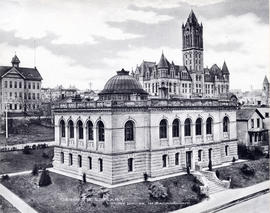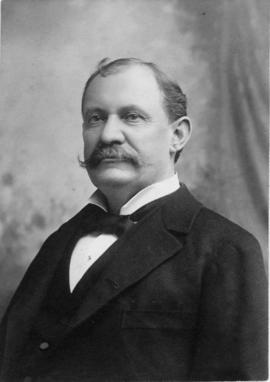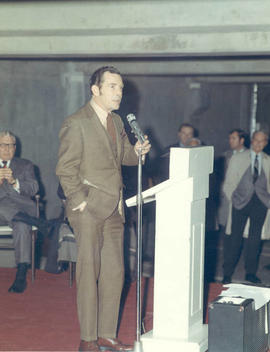The first movement toward creating a library in Tacoma occurred in “New Tacoma” in 1881. The four block area was established in 1869 by Anthony Carr who feared that the name “Tacoma” would be lost in favor of the more popular “Commencement City.” As New Tacoma grew, residents began discussing the need for a library. In 1881, the articles of incorporation for the New Tacoma Library Association were signed. A small number of books were accumulated but borrowing privileges were limited to residents of New Tacoma who purchased a share in the library.
In 1886, a group of three women were discussing books while they sewed. The city of Tacoma was growing rapidly, but books were difficult to find. What the city needed, the women concluded, was a circulating library which would be open to the public. One of the women, Grace Moore, applied her “untiring energy and lifelong devotion to the cause of education” to the effort and took action toward forming the library. By May 5, 1886, Moore had assembled a group of eighteen women to begin the Mercantile Library of Tacoma. The group ordered a collection of paper bound books and set to work binding them in pasteboard to make them more durable. The circulating library opened in Moore’s home before moving to several different spaces around Tacoma including the Otis Sprague Building on the corner of Ninth and C Streets. In order to pay for repairs to the books and the purchase of new items, a fee of 25 cents was charged to borrowers and an additional 5 cents for use of the space as a reading room. Through fees, donations, and fundraisers, the association’s collection quickly grew to 2,000 volumes.
The success of the Mercantile Library gained the attention of a number of prominent citizens and politicians who encouraged the Mayor and City Council to commit financial support to establish a city library. In January of 1889, incorporation papers were filed with the territory of Washington to form the Public Library. According to these original articles, the Library would be governed by seven trustees which would include the Mayor and two additional members of the City Council. The first meeting was held on April 24, 1889.
In 1890, a “gathering of public-spirited citizens” assembled to discuss municipal funding for the library and a new library building. “The people of Tacoma appreciate that hardly anything, aside from its special work, can advertise the city more than the establishment of a library such as is found in eastern cities,” said one attendee. A local businessman in attendance encouraged citizens to “think of the educational advantages derived from a place from which all who wish can get books.”
City Council soon passed a resolution to fund the Library at a rate of $75 per month. In 1891, the Library moved into the Ball Building on C Street. The following year, the City increased funding to $250 per month and committed the fifth floor of the new City Hall to be used by the Library at no charge. All materials that had been accumulated by the Mercantile Library were gifted to the City. William Curtis Taylor was hired as the first City Librarian and the library moved into its new City Hall quarters in 1894, becoming the Tacoma Public Library.
The Library soon outgrew the City Hall space, especially after facilities problems forced a move from the fifth floor to the second. A group of local citizens worked with librarian Reverend S.B. McLafferty to initiate work on a Carnegie grant to fund construction of a dedicated library building. In 1901, it was announced that Tacoma would receive $50,000 from Andrew Carnegie to fund construction on the condition that “the city will provide the site and guarantee $5,000 annually for maintenance of the library.” Soon after, the Carnegie gift was increased to $75,000 when the city agreed to earmark $7,500 annually for maintenance.
A number of possible sites were discussed before the City settled on the northwest corner of Tacoma Avenue and 12th Street, which was accessible by many street car lines. The building was designed by Jardine, Kent, and Jardine of New York and included “an eclectic Renaissance style punctuated by tawny Tenino sandstone and yellow brick from Seattle.” Construction began in 1902 and the library was dedicated on June 4, 1903. It was the first Carnegie Library completed in the state of Washington. The Carnegie building remained the only library facility until the South Tacoma branch opened on May 3, 1911.
n 1946, Tacoma voters approved a library construction bond. While several sites for the new “Main Branch” were considered, the decision was made to build a new large addition onto the Carnegie building. Initial plans by architect Silas E. Nelson included a rooftop parking lot and renovation of the Carnegie building to match the new construction. However, these measures were eliminated due to cost. Some plans even called for the destruction of the Carnegie building altogether. Groundbreaking for the 64,700 square foot building took place on March 20, 1951 and it opened on November 2, 1952.



